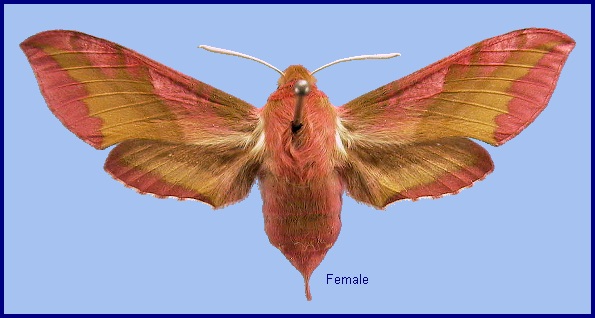
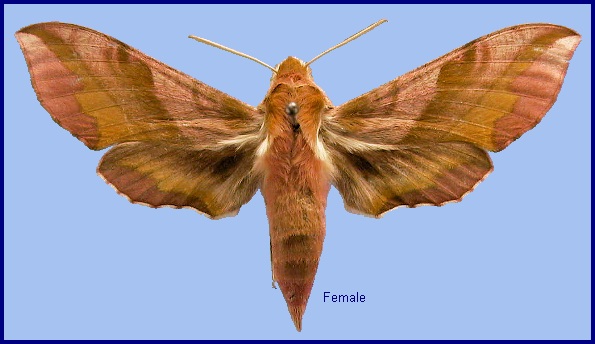
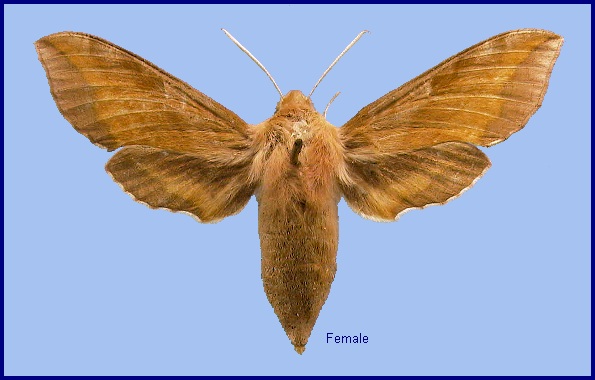
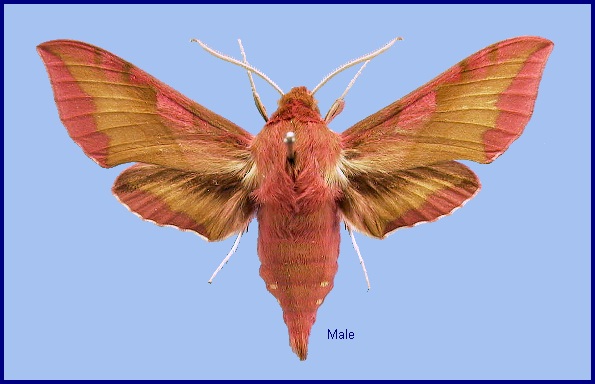
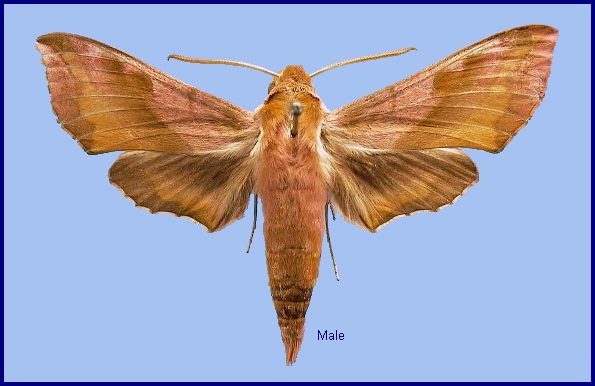
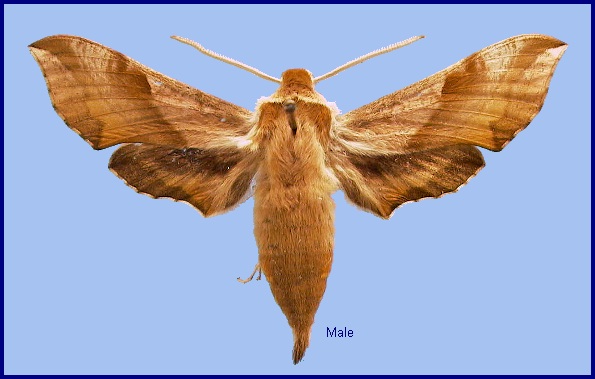
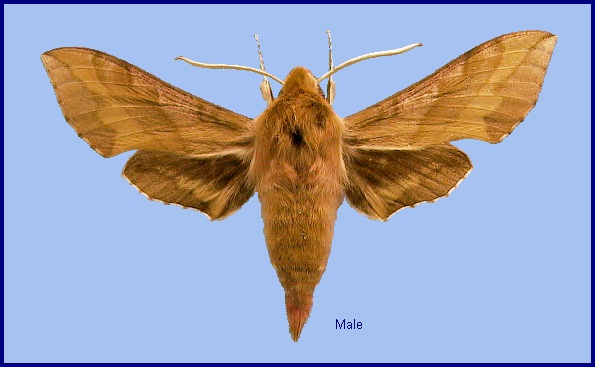
Sphinx porcellus Linnaeus, 1758, Syst. Nat. (Edn 10) 1: 492. Type locality: not stated [Europe].
Synonym. Sphinx porcellus Linnaeus, 1758.
Synonym. Deilephila porcellus var. suellus Staudinger, 1878, Horae Soc. ent. ross. 14: 298.
Synonym. Choerocampa porcellus lutescens Cockerell, 1887.
Synonym. Theretra porcellus clara Tutt, 1904.
Synonym. Theretra porcellus hibernica (Tutt, 1904).
Synonym. Theretra porcellus indistincta Tutt, 1904.
Synonym. Theretra porcellus scotica (Tutt, 1904).
Synonym. Theretra porcellus suffusa Tutt, 1904.
Synonym. Metopsilus porcellus colossus A. Bang-Haas, 1906, Dt. ent. Z. Iris 19: 129.
Synonym. Metopsilus porcellus galbana Gillmer, 1910.
Synonym. Pergesa porcellus flavocincta Wize, 1917.
Synonym. Pergesa porcellus porca O. Bang-Haas, 1927, Horae Macrolepidopt. Reg. palaearct. 1: 80.
Synonym. Pergesa suellus sus O. Bang-Haas, 1927, Horae Macrolepidopt. Reg. palaearct. 1: 80.
Synonym. Pergesa porcellus wesloeensis Knoch, 1929.
Synonym. Pergesa suellus rosea Zerny, 1933, Dt. ent. Z. Iris 47: 60.
Synonym. Pergesa porcellus cingulata O. Bang-Haas, 1934.
Synonym. Pergesa suellus kuruschi O. Bang-Haas, 1938, Ent. Z., Frankf. a. M. 52: 180.
Synonym. Deilephila porcellus decolor Cockayne, 1953.
Synonym. Deilephila porcellus warneckei Capuse, 1963.
Synonym. Deilephila suellus kashgoulii Ebert, 1976, J. ent. Soc. Iran 3: 91.
Synonym. Deilephila suellus sinkiangensis Chu & Wang, 1980, Acta zootaxon. sin. 5: 421. Type locality: China, Xinjiang, Ürümqi, 20-890m [sic].
Synonym. Eumorpha suellus gissarodarvasica Shchetkin, 1981, Izv. Akad. Nauk tadzhik. SSR, (Otdel. Biol. Nauk) (4): 90--92.
Synonym. Deilephila suellus songoricus Eitschberger & Lukhtanov, 1996, Atalanta, Würzburg 27(3-4): 620.
Synonym. Choerocampa suellus sibirica Eitschberger & Zolotuhin, 1997, Atalanta, Würzburg 28(1-2): 145.
Note. Most individuals from China are of the pinkish-brown form that has been described variously as sus (O. Bang-Haas), gissarodarvasica (Shchetkin) and songoricus Eitschberger & Lukhtanov of the subsp. suellus.
Note. The status of Deilephila porcellus 'suellus' presents some problems to some taxonomists. Many regard it as a valid species or subspecies; however, it is almost certainly just an arid-zone form of Deilephila porcellus which diverged from the parent stock in an isolated refugium during the last ice age, and it is treated as such in this work. The two races have since come together again and are now intergrading in Turkey, northern Iran and the Tian Shan. Further evidence for the form status of suellus is supplied by temperature-breeding experiments with British porcellus: heat applied to developing pupae can result in adults which are externally almost identical to those of 'suellus'. For these and other reasons, all attempts to describe 'subspecies' of porcellus should be abandoned.
Wingspan: 45--51mm. A very variable species with regard to the amount of pink and brown coloration on the body and wings. Similar to European examples of Deilephila porcellus, but nearly all pink coloration replaced by sandy buff; however, most Chinese examples are slightly pinkish. In f. suellus, (which is considered by some authors to be a separate species), the ground colour is pale brown with lighter brown bands on the uppersides of the wings; in f. porcellus, the costal margin and submarginal band are pink and the remainder of the wing is a more uniformly coloured khaki brown. There are numerous intermediate forms, in which the degree of pink coloration is expressed to a greater or lesser extent; these are considered by some authors to represent subspecies of either porcellus or suellus. However, there is some evidence that this colour variation may be, at least in part, environmentally determined. Pronotum in f. suellus edged with grey, as in Deilephila askoldensis, but less distinctly. Abdominal tergites five and six each with a yellowish lateral apical spot (in f. suellus). Pale lateral border of tegula continued to frons, more or less distinct on pronotum (f. suellus).
In the male genitalia, uncus about half the width of the gnathos, convex apically, weakly hooked in lateral view. Gnathos truncate, with angles rounded. Valve broad, with approximately 12 stridulatory scales. Harpe shorter than in Deilephila elpenor elpenor. Phallus with apical dentate shorter than in Deilephila elpenor elpenor.
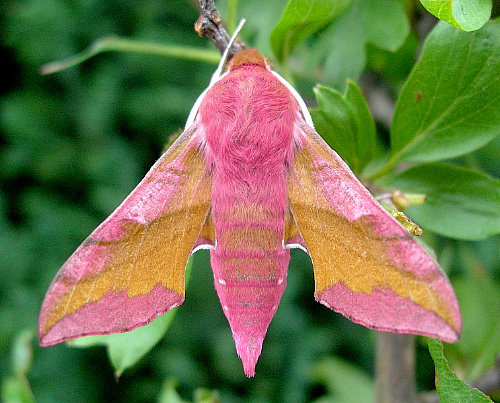
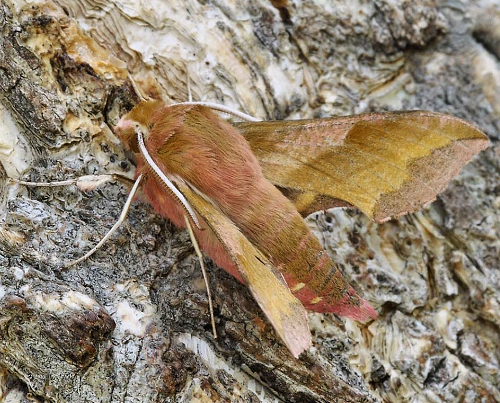
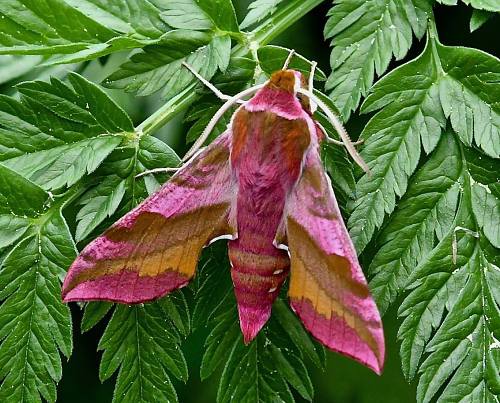
Frequents open, dry montane forest, or scrub with a good ground cover of herbs. Usually found at about 2500m, rarely below 2000m.
Little known in China, but in neighbouring Kazakhstan adults fly mainly from mid-June until mid-July, although some individuals may fly as early as mid-May.
China: 31.v (Ürümqi); vi (Yining/Gulja); 2-20.vi (Shihezi); 6.viii (Shihezi). Mongolia: 28-31.v (Gov'-Altai Province; Khovd Province); 3-11.vi (Khovd Province; Gov'-Altai Province); 1-22.vii (Khovd. Province; Bayan-Ölgiy Province). Russia: 31.v-11.vi (Altai); 5.vi-20.vii (Siberia); 21.vi (Transbaikalia); 15.vii (Altai); 19.vii (Buryatia).
OVUM: Clear green, changing to yellowish green before hatching. Oval (1.05 x 1.20), shiny and smooth, with a dorsal depression. Laid singly near the growing tips of the hostplant, often two or three to a clump of shoots.
LARVA: Full-fed 60--70mm. Dichromatic: brown and green. A study of the very detailed description given by Degtyareva & Shchetkin (1982) of a larva of Eumorpha suellus gissarodarvasica Shchetkin (= Deilephila porcellus f. suellus) taken in the Darai-Nazarak Gorge, Gissar Mountains, Tajikistan, reveals no discernible difference between the larva of Deilephila porcellus at either end of its range.
On hatching, the larva is approximately 3mm long, pale greyish green, with a tinge of yellow ventrally and two small tubercles in place of a tail horn. In the second and third instars the primary green colour darkens, a pale dorso-lateral line appears and the caudal tubercles are pink. In the next moult the eye-spots and a dark bloom develop on the body, the bloom becoming dominant in the final instar when most assume a grey-brown coloration; only a few remain green. If the larva is alarmed at this stage, it retracts its head and thoracic segments causing the eye-spots on abdominal segment 1 to become prominent. If this fails to deter the 'attacker', Deilephila porcellus then feigns death, becoming completely limp and flaccid. Fully grown, nearly all feed by night, resting during daylight hours low down on the hostplant. Although a mixed diet of flowers and leaves is initially preferred, when feeding on Galium, many make do with leaves only with no ill-effects. Prior to pupation the skin darkens, an event more noticeable in the rare green form; the larva may then travel a considerable distance in search of a suitable pupation site.
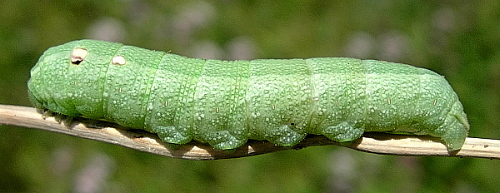
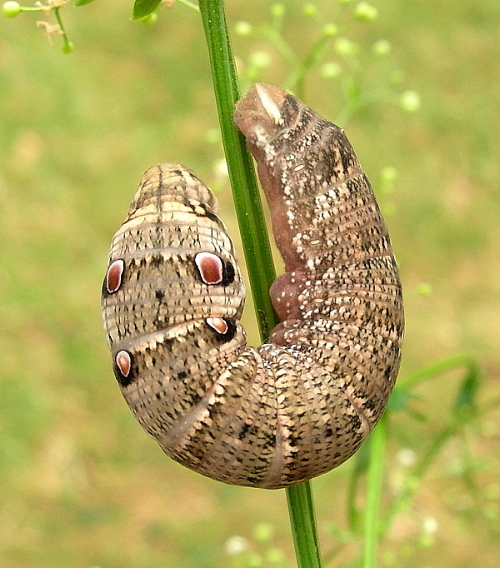
PUPA: 25--31mm. Light brown with streaks and dashes of darker brown; prominent eyes, a cariniform proboscis and a pointed, triangular, downward-curving cremaster. As in Deilephila elpenor, there is a semi-circle of small hooks on each movable abdominal segment. Pupation takes place in a loosely spun cocoon amongst litter on the ground or sometimes under a stone. The overwintering stage.
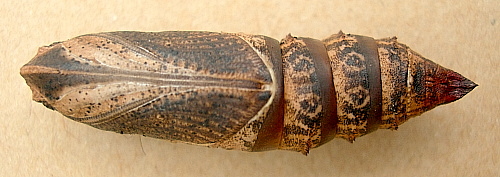
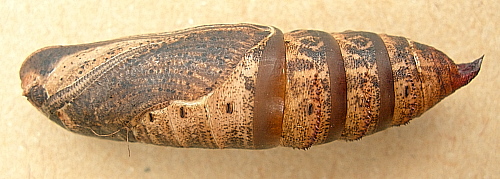
Larval hostplants. Unknown in China, but in Europe the major hostplant is Galium.
Unknown for the region.
China: Xinjiang (Ürümqi; Shihezi; Tacheng; Yining/Gulja, 900-1200m; Aksu); Nei Mongol (Ewenkizu; Ergun Youqi).
Kyrgyzstan: Issyk-Kul.
Mongolia: Khovd Province (Bodonchiyn River basin, Hundiyin River, 1600m (46°06'N 92°30'E); Uenchin River valley, 50 km N Uench village, 1500m; Barlagiyn River valley, 25 km NW Altan-Soembo, 1700m (45°53'N 93°05'E); Bulgan River basin, Bayan river valley, Arshantyn-Nuruu Mts., Ulyastayn-Sala River, 1900m (46°21'N 91°08'E); Bajtag-Bogd-Uul Mts., Baruun-Khargaityn-Gol (River) Valley, 2000m (45°16'N 90°57'E)); Gov'-Altai Province (Mongolian Altai Mts. (south slope), Mogoiyn River Valley, 1800m (45°39'N 93°47'E); Adzh-Bogdo Mts. (NE slope), near Mt. Khalba-Khairkhan, 1700m (45°03;N 94°59'E)); Bayan-Ölgiy Province (Kara-Irtys river basin, middle stream of Elt River, 2100-2300m; Kobdo River valley, 20km SW Tsengel, 1800m).
Russia: Altai (Ongodai; Krasnoshchekovo; Barnaul; Gorno-Altaysk); Siberia (Tomsk area; Krasnoyarsk; Achinsk; Zapovednik; Kaylya; Shirokaya Kur'ya; Novosibirsk; Karasuk; Ordynskoe; Chingisy; Izdrevaya; Maslyanono; Alaevo; Kultuk, Lake Baikal; Krutoyarsky; Pozdnyakovo; Kireevsk); Yakutia (Lensk; Yakutsk; Ust Maya); Buryatia (Baikalskii Nature Reserve; Erkhirik); Transbaikalia (Sivachi; Mogocha; Nizhnii Tsasuchei; Sokhondinskii Nature Reserve (Nizhnii Bukukun); Kyra); Amurskaya (Zeiskii Nature Reserve).
Recorded by Pittaway (1993) as a non-migratory resident occurring throughout Europe (with the exception of northern Scandinavia, northern Scotland and parts of the Iberian Peninsula) to Turkey and south to the Lebanese mountains and northeastern Iraq; then eastward across the Caucasus Mountains, northern Iran, southern Turkmenistan and Uzbekistan, Tajikistan, Kyrgyzstan and eastern Kazakhstan (Pittaway, 1993; Danner et al., 1998). In the north, Deilephila porcellus extends eastward across European Russia and the Crimea to Novosibirsk in western Siberia (Zolotarenko et al., 1978), Yakutia (Kaimuk et al., 2005), eastern Kazakhstan (Zolotarenko et al., 1978), the Altai Mountains of Russia and Mongolia (Puntsagdulam et al., 2005; Gusíkova & Yakovlev, 2011; Yakovlev, Gus'kova, Doroshkin & Titov, 2015; Yakovlev & Doroshkin, 2017; Makhov, Matov & Lukhanov, 2024), Lake Baikal (Derzhavets, 1984), Transbaikalia (Oleg Korsun, pers. comm. 2004), Amurland (V. Dubatolov, pers. comm.) and neighbouring Inner Mongolia (Ma, Li & Kang, 1991). Also present in the Atlas Mountains of north Africa.
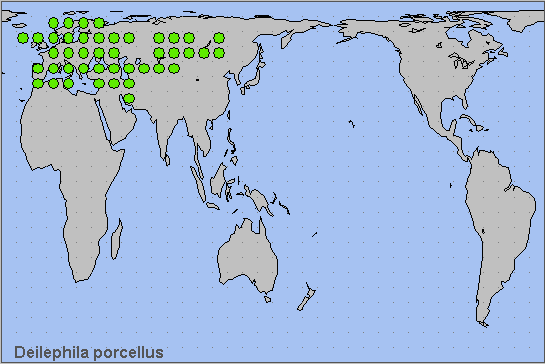
Holarctic; western Palaearctic region. Pleistocene refuge: Polycentric -- Adriatomediterranean and Pontomediterranean subsections of the Mediterranean refuge as one population; Atlantomediterranean and Mauritanian subsections of the Mediterranean refuge as another distinct population; and the Syrian, Iranian and Turkestan refugia, with slightly different forms evolving in each. The latter have since almost totally merged with each other.
 Return to Sphingidae of the Eastern Palaearctic species list
Return to Sphingidae of the Eastern Palaearctic species list